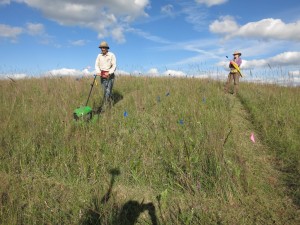Description:
This experiment assesses effects of fire on the fitness of Cirsium hillii (Hill’s thistle) plants at Hegg Lake WMA. Like Echinacea, C. hillii inhabits dry prairies, but Hill’s thistle is listed as a Species of Special Concern in Minnesota and little is known about how it responds to fire. Burn and non-burn units were created prior to an experimental fall burn conducted by the DNR in 2014. That year, we mapped 28 C. hillii plants (basal and flowering).
In 2015, Team Echinacea collected tissue samples from these individuals for analysis by Abbey White, a MS student in Northwestern’s Plant Biology and Conservation Program. Abbey used microsatellite markers to describe patterns of genetic diversity across the Midwestern range of C. hillii and determine if inbreeding or clonal growth contribute to the low seed set observed in the region. So far she has found evidence for a lot of clonal growth. This has a direct application to the restoration of C. hillii since the number of plants we see may not represent the number of genetic individuals in the population.
We revisit plant locations annually to assess their survival and reproduction.
Start year: 2014
Location: Hegg Lake WMA
Overlaps with: fire and flowering at Staffanson Prairie Preserve
Link to flog posts: Read updates about C. hillii fire & fitness as written by members of Team Echinacea on our flog (field blog).
